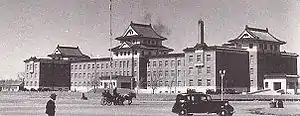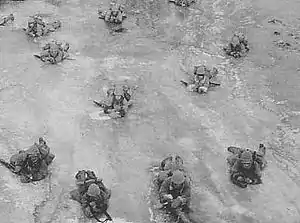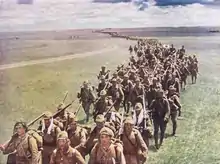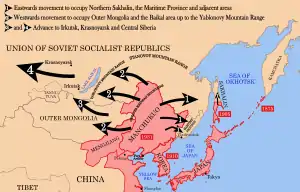Kwantung Army
The Kwantung Army (Japanese: 関東軍, Kantō-gun) was the largest army group of the Imperial Japanese Army from 1919 to 1945.
| Kwantung Army | |
|---|---|
| Japanese: 関東軍 Kantō-gun | |
 | |
| Active | April 1919 – August 1945 |
| Country | |
| Allegiance | Emperor of Japan |
| Branch | |
| Type | Infantry |
| Role | Army group |
| Size | 300,000 (1940) 763,000 (1941) 713,000 (1945) |
| Garrison/HQ | Ryojun, Kwantung Leased Territory (1906–1932) Hsinking, Manchukuo (1932–1945) |
| Nickname(s) | Toku (德兵團, Toku heidan), Special |
| Engagements | Second Sino-Japanese War
|
| Kwantung Army | |||||||||||||||
|---|---|---|---|---|---|---|---|---|---|---|---|---|---|---|---|
| Chinese name | |||||||||||||||
| Traditional Chinese | 關東軍 | ||||||||||||||
| Simplified Chinese | 关东军 | ||||||||||||||
| |||||||||||||||
| Korean name | |||||||||||||||
| Hangul | 관동군 | ||||||||||||||
| Hanja | 關東軍 | ||||||||||||||
| |||||||||||||||
| Japanese name | |||||||||||||||
| Kanji | 関東軍 | ||||||||||||||
| |||||||||||||||
The Kwantung Army was formed in 1906 as a security force for the Kwantung Leased Territory and South Manchurian Railway Zone after the Russo-Japanese War, and was expanded into an army group during the Interwar period to support Japanese interests in China, Manchuria, and Mongolia. The Kwantung Army became the largest and most prestigious command in the Imperial Japanese Army, and many of its personnel were promoted to high positions in the Japanese military and civil government, including Hideki Tōjō and Seishirō Itagaki. The Kwantung Army was largely responsible for the creation of the Japanese puppet state of Manchukuo and was one of the main Japanese fighting forces during the Second Sino-Japanese War from 1937.
In August 1945, the Kwantung Army was engaged by Soviet troops during the Manchurian Strategic Offensive Operation. The Kwantung Army surrendered to the Soviets the day after the Surrender of Japan and was subsequently dissolved. The Kwantung Army was responsible for many of the worst Japanese war crimes during World War II, including the sponsorship of Unit 731 which performed biological warfare and human experimentation on civilians and prisoners of war.
History
Formation

In 1895, Qing China had granted the Kwantung Leased Territory, a valuable concession territory on the Liaodong Peninsula, to the Empire of Japan in the Treaty of Shimonoseki after their victory in the First Sino-Japanese War. The term "Kwantung" (traditional Chinese: 關東; simplified Chinese: 关东; pinyin: Guāndōng; Wade–Giles: Kwan1-tung1) means "east of Shanhaiguan", a guarded pass west of Manchuria, which was rendered in Japanese as "Kantō". The Russian Empire had particular interest in Kwantung, being one of the few areas in the region with potential to develop ice-free ports for its own expansion in the Far East, and Qing authorities withdrew the lease from the Japanese following the Triple Intervention, only weeks after it had been granted. Kwantung was leased to Russia in 1898, becoming Russian Dalian (Дальний) and developing the territory into a thriving trade port. The Russo-Japanese War was fought between Russia and Japan from 1905 to 1906 over their rival imperial ambitions in Manchuria and Korea. Japanese victory led to the Republic of China returning the lease of Russian Dalian (re-establishing the Kwantung Leased Territory) and Japan gaining influence in the areas adjacent to the South Manchurian Railway.
The Kwantung Garrison was established in 1906 to defend this territory, and originally was composed of an infantry division and a heavy siege artillery battalion, supplemented with six independent garrison battalions as railway guards deployed along the South Manchurian Railway Zone, for a total troop strength of 100,000 men. The Kwantung Garrison was headquartered in Port Arthur (known as Ryojun in Japanese) and after a reorganization in 1919, the Kwantung Garrison was renamed the Kwantung Army (Kantō-gun).
In the highly politicized Imperial Japanese Army of the 1920s and 1930s, the Kwantung Army was a stronghold of the radical "Imperial Way Faction" (Kōdōha), and many of its senior leaders overtly advocated political change in Japan through the violent overthrow of the civilian government to bring about a Shōwa Restoration, with a reorganization of society and the economy along totalitarian state fascist lines. They also advocated a more aggressive, expansionist foreign policy regarding the Asian mainland. Members or former members of the Kwantung Army were active in numerous coup d'état attempts against the civilian government, culminating with the February 26 Incident of 1936, where the Kōdōha faction was de facto dissolved.[1]
Independent actions
Although the Kwantung Army was nominally subordinate to the Imperial General Headquarters and the senior staff at the Army General Staff located in Tokyo, its leadership often acted in direct violation of the orders from mainland Japan without suffering any consequence. Conspirators within the junior officer corps of the Kwantung Army plotted and carried out the assassination of Manchurian warlord Zhang Zuolin in the Huanggutun Incident of 1928. Afterward, the Kwantung Army leadership engineered the Mukden Incident and the subsequent invasion of Manchuria in 1931, in a massive act of insubordination (gekokujo) against the express orders of the political and military leadership based in Tokyo.
Presented with the fait accompli, Imperial General Headquarters had little choice but to follow up on the actions of the Kwantung Army with reinforcements in the subsequent Pacification of Manchukuo. The success of the campaign meant that the insubordination of the Kwantung Army was rewarded rather than punished. In 1932, the Kwantung Army was the main force responsible for the foundation of Manchukuo, the puppet state of Japan located in Northeast China and Inner Mongolia. The Kwantung Army played a controlling role in the political administration of the new state as well as in its defense. With the Kwantung Army, administering all aspects of the politics and economic development of the new state, this made the Kwantung Army's commanding officer equivalent to a Governor-General with the authority to approve or countermand any command from Puyi, the nominal Emperor of Manchukuo.[2] As testament to the Kwantung Army's control over the government of Manchukuo was the fact that the Commander-in-Chief of the Kwantung Army also doubled as the Japanese Ambassador of Manchukuo.[3]
Second World War


After the campaign to secure Manchukuo, the Kwantung Army continued to fight in numerous border skirmishes with China as part of its efforts to create a Japanese-dominated buffer zone in Northern China. The Kwantung Army also fought in Operation Nekka during the preceding phase of the Second Sino-Japanese War, and various actions in Inner Mongolia to extend Japanese domination over portions of northern China and Inner Mongolia. When full-scale war broke out in the Marco Polo Bridge Incident in July 1937, its forces participated in Battle of Beiping-Tianjin and Operation Chahar. Later, Kwantung forces supported the war in China from time to time.
However, by the late 1930s the Kwantung Army's vaunted reputation was severely challenged during the Soviet–Japanese border conflicts that Japan had fought against the Soviet Union in northern Manchukuo since 1932. The Japanese force stalemated with the Soviet Union's Red Army in the Battle of Lake Khasan in 1938, and lost the decisive Battle of Nomonhan in 1939, during which time it sustained heavy casualties. After the "Nomonhan incident", the Kwantung Army was purged of its more insubordinate elements, as well as proponents of the Hokushin-ron ("Northward Advance") doctrine who urged that Japan concentrate its expansionist efforts on Siberia rather southward towards China and Southeast Asia.[4]
The Kwantung Army was heavily augmented over the next few years, up to a strength of 700,000 troops by 1941, and its headquarters was transferred to the new Manchukuo capital of Hsinking. The Kwantung Army also oversaw the creation, training, and equipping of an auxiliary force, the Manchukuo Imperial Army. During this time, Prince Tsuneyoshi Takeda worked as liaison officer between the Imperial house and the Kwantung Army.[5] Although a source of constant unrest during the 1930s, the Kwantung Army remained remarkably obedient during the 1940s. As combat spread south into Central China and Southern China in the Second Sino-Japanese War, and with the outbreak of the Pacific War, Manchukuo was largely a backwater to the conflict. However, as the war situation began to deteriorate for the Imperial Japanese Army on all fronts, the large, well-trained, and well-equipped Kwantung Army could no longer be held in strategic reserve. Many of its front line units were systematically stripped of their best units and equipment, which were sent south to fight in the Pacific War against the forces of the United States in the Pacific Islands or the Philippines. Other units were sent south into China for Operation Ichi-Go.
Surrender of the Kwantung Army
By 1945, the Kwantung Army consisted of 713,000 personnel, divided into 31 infantry divisions, nine infantry brigades, two tank brigades, and one special purpose brigade. It also possessed 1,155 light tanks, 5,360 guns, and 1,800 aircraft. The quality of troops had fallen drastically, as all the best men and materiel were siphoned off for use in other theaters. These forces were replaced by militia, draft levies, reservists, and cannibalized smaller units, all equipped with woefully outdated equipment.[6] The Kwantung Army had also bacteriological weapons, prepared for use against Soviet troops (see Unit 731). The bulk of military equipment (artillery, tanks, aircraft) was developed in the 1930s, and very few of the soldiers had sufficient training or any real experience.

The final commanding officer of the Kwantung Army, General Otozō Yamada, ordered a surrender on August 16, 1945, one day after Emperor Hirohito announced the surrender of Japan in a radio announcement. Some Japanese divisions refused to surrender, and combat continued for the next few days. Marshal Hata received the "ultimatum to surrender" from Soviet General Georgii Shelakhov[7][8] in Harbin on August 18, 1945.[7] He was one of the senior generals who agreed with the decision to surrender, and on August 19, 1945, Hata met with Marshal Aleksandr Vasilevsky,[9] but asked that he be stripped of his rank of Field Marshal in atonement for the Army's failures in the war.[10]
The remnants of the Kwantung Army were either dead or on their way to Soviet prisoner-of-war camps. Over 500,000 Japanese prisoners of war were sent to work in Soviet labor camps in Siberia, Russian Far East and Mongolia. They were largely repatriated, in stages, over the next five years, though some continued to be held well into the 1950s.
War crimes and trials
After the surrender of Japan, the Soviet Red Army discovered secret installations for experimenting with and producing chemical weapons and biological weapons of mass destruction centered around secret Army Unit 731 and its subsidiaries.[8] At these locations, the Kwantung Army was also responsible for some of the most infamous Japanese war crimes, including the operation of several human experimentation programs using live Chinese, American and Russian[11] civilians, and POWs, directed by Dr. Shiro Ishii.
Arrested by the American occupation authorities, Ishii and the 20,000 members of Unit 731 received immunity from prosecution of war-crimes before the Tokyo tribunal of 1948, in exchange for germ warfare data based on human experimentation. On May 6, 1947, General Douglas MacArthur wrote to Washington that "additional data, possibly some statements from Ishii probably can be obtained by informing Japanese involved that information will be retained in intelligence channels and will not be employed as 'War Crimes' evidence".[12] The deal was concluded in 1948. However, twelve members of Unit 731 and some members of the World War II leadership of the Kwantung Army were sentenced as war criminals by the Khabarovsk War Crime Trials, while others were taken into custody by the United States, and sentenced at the 1948 International Military Tribunal for the Far East in Tokyo. Among those sentenced to death were former generals Seishirō Itagaki, Iwane Matsui, Kenji Doihara, Hideki Tōjō and Akira Mutō.
List of commanders
Commanding officer
| Name | From | To | |
|---|---|---|---|
| 1- | General Tachibana Kōichirō | 1919 | 6 January 1921 |
| 2 | General Misao Kawai | 6 January 1921 | 10 May 1922 |
| 3 | General Shinobu Ono | 10 May 1922 | 10 October 1923 |
| 4 | General Yoshinori Shirakawa | 10 October 1923 | 28 July 1926 |
| 5 | Field Marshal Baron Nobuyoshi Mutō | 28 July 1926 | 26 August 1927 |
| 6 | General Chotaro Muraoka | 26 August 1927 | 1 July 1929 |
| 7 | General Eitaro Hata | 1 July 1929 | 31 May 1930 |
| 8 | General Takashi Hishikari | 3 June 1930 | 1 August 1931 |
| 9 | General Shigeru Honjō | 1 August 1931 | 8 August 1932 |
| 10 | Field Marshal Baron Nobuyoshi Mutō | 8 August 1932 | 27 July 1933 |
| 11 | General Takashi Hishikari | 29 July 1933 | 10 December 1934 |
| 12 | General Jirō Minami | 10 December 1934 | 6 March 1936 |
| 13 | General Kenkichi Ueda | 6 March 1936 | 7 September 1939 |
| 14 | General Yoshijirō Umezu | 7 September 1939 | 18 July 1944 |
| 14 | General Otozō Yamada | 18 July 1944 | 11 August 1945 |
Chief of Staff
| Name | From | To | |
|---|---|---|---|
| 1 | Major General Matasuke Hamamo | 12 April 1919 | 11 March 1921 |
| 2 | Major General Kaya Fukuhara | 11 March 1921 | 6 August 1923 |
| 3 | Major General Akiharu Kawada | 6 August 1923 | 2 December 1925 |
| 4 | Major General Tsune Saito | 2 December 1925 | 10 August 1928 |
| 5 | Lieutenant General Koji Miyake | 10 August 1928 | 8 August 1932 |
| 6 | General Kuniaki Koiso | 8 August 1932 | 5 March 1934 |
| 7 | General Toshizo Nishio | 5 March 1934 | 23 March 1936 |
| 8 | General Seishirō Itagaki | 23 March 1936 | 1 March 1937 |
| 9 | General Hideki Tōjō | 1 March 1937 | 30 May 1938 |
| 10 | Lieutenant General Rensuke Isogai | 18 June 1938 | 7 September 1939 |
| 11 | Lieutenant General Jo Iimura | 7 September 1939 | 22 October 1940 |
| 12 | General Heitarō Kimura | 22 October 1940 | 10 April 1941 |
| 13 | General Teiichi Yoshimoto | 10 April 1941 | 1 August 1942 |
| 14 | Lieutenant General Yukio Kasahara | 1 August 1942 | 7 April 1945 |
| 15 | Lieutenant General Hikosaburo Hata | 7 April 1945 | 11 August 1945 |
See also
- Military history of Japan
- Armies of the Imperial Japanese Army
- Organization of the Kwantung Army
- Zhongma Fortress – site of chemical and biological warfare research
- Kantokuen – cancelled Japanese invasion of the Soviet Far East
References
Citations
- Harries, Soldiers of the Sun: The Rise and Fall of the Imperial Japanese Army
- Young, Japan's Total Empire: Manchuria and the Culture of Wartime Imperialism.
- Culver, Margaret S. "Manchuria: Japan's Supply Base." Far Eastern Survey, vol. 14, no. 12, 1945, pp. 160–163.
- Coox, Nomonhan: Japan Against Russia, 1939
- Yamamuro, Manchuria Under Japanese Domination.
- Glantz, p. 28
- "ВОЕННАЯ ЛИТЕРАТУРА --[ Мемуары ]-- Белобородов А.П. Прорыв на Харбин". militera.lib.ru.
- "Гудок.RU - Новости железнодорожного транспорта, машиностроения и логистики". gudok.ru.
- The Soviet Strategic Offensive in Manchuria, 1945: August Storm By David M. Glantz.
- Budge, Pacific War Online Encyclopedia
- "Unit 731". Archived from the original on April 30, 2009.
- Hal Gold, Unit 731 Testimony, 2003, p. 109
Sources
- LTC David M. Glantz, "August Storm: The Soviet 1945 Strategic Offensive in Manchuria". Leavenworth Papers No. 7, Combat Studies Institute, February 1983, Fort Leavenworth Kansas.
- Coox, Alvin (1990). Nomonhan: Japan Against Russia, 1939. Stanford University Press. ISBN 0-8047-1835-0.
- Coox, Alvin (1977). The Anatomy of a Small War: The Soviet-Japanese Struggle for Changkufeng/Khasan, 1938. Greenwood Press. ISBN 0-8371-9479-2.
- Dorn, Frank (1974). The Sino-Japanese War, 1937-41: From Marco Polo Bridge to Pearl Harbor. MacMillan. ISBN 0-02-532200-1.
- Glantz, David (2003). The Soviet Strategic Offensive in Manchuria, 1945 (Cass Series on Soviet (Russian) Military Experience, 7). Routledge. ISBN 0-7146-5279-2.
- Harries, Meirion (1994). Soldiers of the Sun: The Rise and Fall of the Imperial Japanese Army. Random House; Reprint edition. ISBN 0-679-75303-6.
- Yamamuro, Shinichi (2005). Manchuria Under Japanese Domination. University of Pennsylvania Press. ISBN 0-8122-3912-1.
- Young, Louise (1999). Japan's Total Empire: Manchuria and the Culture of Wartime Imperialism. University of California Press. ISBN 0-520-21934-1.
- Jowett, Bernard (1999). The Japanese Army 1931-45 (Volume 2, 1942-45). Osprey Publishing. ISBN 1-84176-354-3.
- Madej, Victor (1981). Japanese Armed Forces Order of Battle, 1937-1945. Game Publishing Company. ASIN: B000L4CYWW.
- Marston, Daniel (2005). The Pacific War Companion: From Pearl Harbor to Hiroshima. Osprey Publishing. ISBN 1-84176-882-0.
External links
- Wendel, Marcus. "Axis History Factbook". Kwantung Army.